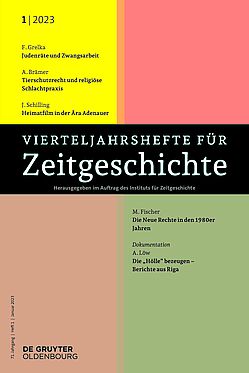Issue 1/2023
Content Overview: English Titles and Abstracts:
- Frank Grelka, Where Work Was No Way Out. Jewish Councils and Forced Labour in the Cities of the General Government, 1939 to 1941. - A deeper look into the issue, Newspaper Article Der Spiegel
- Andreas Brämer, Animal Welfare Law and Religious Slaughter Practice. Shechita as a Contentious Ritual in the Federal Republic of Germany.
- Jonathan Schilling, More than Heimatfilm. Ruth Leuwerik, “The Trapp Family” and Popular Taste during the Adenauer Years.
- Moritz Fischer, The New Right in the Last Decade of the Bonn Republic. Armin Mohler, Franz Schönhuber, Hellmut Diwald and the Foundation of the “Deutschlandrat” in 1983.
- Andrea Löw, Testifying to “Hell”. Early Reports of Surviving German Jews from Riga.
Abstracts
Frank Grelka, Where Work Was No Way Out. Jewish Councils and Forced Labour in the Cities of the General Government, 1939 to 1941
While the National Socialist persecution of the Jews has repeatedly been described as a history of robbery, the concrete practices of an economy based on forced labour have only been researched to some extent. Frank Grelka argues that the labour and financial policy of the government of the General Government did not follow an economic rationality, but rather that it formed the beginning of the Holocaust in Poland. To demonstrate this, he analyses the example of Częstochowa in comparison to Warsaw and Lublin in order to show how the local Jewish Councils attempted to resist persecution by way of life-threatening forced labour with their communities’ diminishing resources. They generally recruited only the most underprivileged members of the community for German forced labour camps and their aim was explicitly not to create employment to save lives.
Andreas Brämer, Animal Welfare Law and Religious Slaughter Practice. Shechita as a Contentious Ritual in the Federal Republic of Germany
The article considers the discussions which were conducted regarding Jewish slaughter practices in Western Germany after 1945. In particular, it investigates a period during which the dispute about the requirement to stun warm-blooded animals practically only related to the religious practices of about 20 000 to 25 000 adherents of the Jewish community. In reviewing the different actors in this debate for and against kosher slaughter, the author devotes particular attention to Jewish positions. The analysis is not only about interpreting the attitudes of post-war West German society, but also about establishing the extent of Jewish room for manoeuvre.
Jonathan Schilling, More than Heimatfilm. Ruth Leuwerik, “The Trapp Family” and Popular Taste during the Adenauer Years
Using hitherto unused sources, the author illuminates the preferences of the West German film-going public of the 1950s. The focus is on Ruth Leuwerik as the most popular actress and “The Trapp Family” as the most viewed film of this period. However, the findings suggest that the common preconception that the Heimatfilm was the most popular genre of the period has to be relativized. Jonathan Schilling shows that this cliché predominantly stems from left-wing film criticism of the 1950s and 1960s, which created a caricature of the Heimatfilm as a backdrop for its polemics. A differentiated view of the topic allows for a review of 1950s film in a new light.
Moritz Fischer, The New Right in the Last Decade of the Bonn Republic. Armin Mohler, Franz Schönhuber, Hellmut Diwald and the Foundation of the “Deutschlandrat” in 1983
The “Deutschlandrat” founded in 1983 was one of the most important attempts of the New Right to organise itself and create a common discussion platform in the history of the Federal Republic. Among its members were Armin Mohler, Hellmut Diwald and Franz Schönhuber, who had high hopes for this endeavour. The article takes a behind-the-scenes view and places it within the history of the New Right of the Bonn Republic. This shows that the “Deutschlandrat” was a project to regain influence on West German Conservatism, which had liberalised itself during the 1970s. The attempt to counter the marginalisation of the positions of the New Right in the West German debates about identity ultimately failed. Feeling resigned and disappointed, Mohler and Diwald as well as others turned towards party politics and got involved with the project of their friend Schönhuber, who wanted to use the Republikaner party founded in 1983 in order to turn New Right ideology into practical politics.
Andrea Löw, Testifying to “Hell”. Early Reports of Surviving German Jews from Riga
The systematic deportation of German Jews to “the East” began in autumn 1941. One of the destinations was Riga; between 27 November 1941 and 6 February 1942, twenty transports with a total of about 20 000 people arrived at Riga-Skirotava goods station. Those on the first transport from Berlin were shot by SS and police directly after arrival, while the people in the following trains were taken to various places in and around Riga: the Jungfernhof Camp, the Riga Ghetto and the Salaspils Camp. Immediately after the war some survivors recorded how they had survived after the deportation in places which they sometimes referred to as “hell”. Some of these testimonies are presented here.

